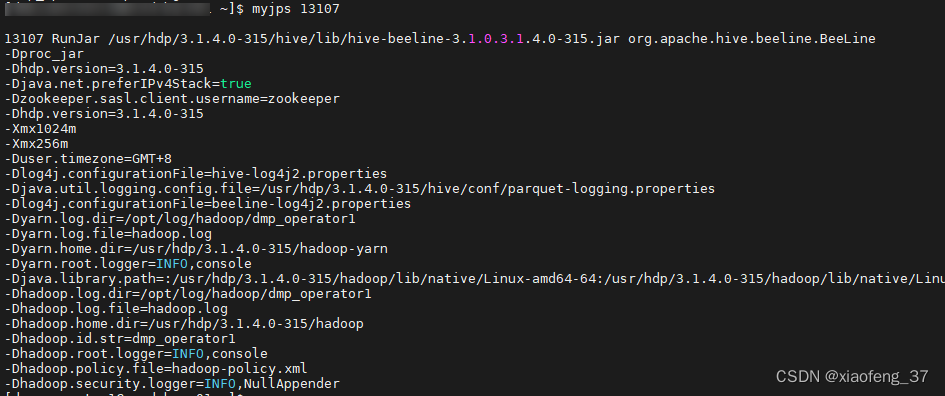
linux使用jps查看java进程信息 单进程详细信息查看
使用jps查看进程信息,查看进程的详细信息,使用jps查看单个进程的详细信息,grep的使用,linux如何自定义函数
·
前言
在开发中,我们经常需要使用jps工具查看Java进程信息,很方便。不过如果我们想查看详细信息的时候,输出的信息过多且未格式化,很不方便查看,这里介绍一个很快捷的方法对繁杂的信息进行格式化。
提示:以下是本篇文章正文内容,下面案例可供参考
一、jps介绍
jps命令时java自带的命令,只需配置好JAVA_HOME并把$JAVA_HOME/bin添加到PATH变量即可使用。
我们可以使用man jps查看参数的详细解释
SYNOPSIS
jps [ options ] [ hostid ]
OPTIONS
The jps command supports a number of options that modify the output of the command. These options are subject to change or removal in the future.
-q `只输出进程号` Suppresses the output of the class name, JAR file name, and arguments passed to the main method, producing only a list of local JVM identifiers.
-m `很多详细信息:进程号,main方法名,jar包,传递给main方法的各种参数(如果使用beeline -e进进行查询我们还可以看到完整的SQL)` Displays the arguments passed to the main method. The output may be null for embedded JVMs.
-l `进程号和完整的main方法名` Displays the full package name for the application's main class or the full path name to the application's JAR file.
-v `实际传递给JVM的一堆参数(内存/日志等)配置` Displays the arguments passed to the JVM.
-V `进程号和简短的main方法名` Suppresses the output of the class name, JAR file name, and arguments passed to the main method, producing only a list of local JVM identifiers.
此处推荐 `jps -m -v`,也可合并写成`jps -mv`
二、自定义shell函数
此处推荐一篇博文,介绍了linux中使用脚本/alias/function实现自定义函数的几种方法
如何自定义shell脚本——linux中别名alilas和函数function的使用
1. 切换到家目录编辑.bashrc
$ cd ~
$ vim .bashrc
#查看jps详情
function myjps(){
jps -mv | grep ${1:-''} | sed 's/-D/\n-D/g;s/-X/\n-X/g;s/^/\n/g'
}
$ source .bashrc # 或者 source $_ ($_会取到上条命令的最后一个参数)
# 此处也使可用全局配置文件/etc/porfile, 不过不推荐
2. grep ${1:-‘’} 解释
因为jps不能指定进程号进行单独查询,进程过多时使用-mv会打出过多信息,这里使用grep命令曲线实现查询单个jps的功能
3. 使用
先试用jps -l/m 找到想要关注的进程号

使用myjps pidId查看详细信息,也可不带参数展示所有进程的相信信息

更多推荐
 已为社区贡献1条内容
已为社区贡献1条内容






所有评论(0)